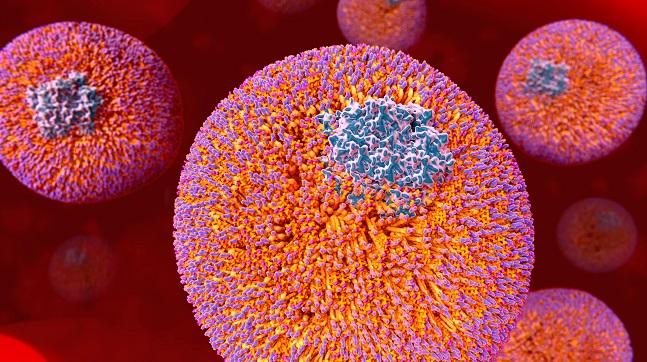Beyond LDL Cholesterol: Lipoprotein Particles Linked With MI and Ischemic Stroke
Various lipids and lipoproteins, as well as metabolite markers, show a very weak relationship with intracerebral hemorrhage.

Multiple plasma lipoprotein particles and metabolic markers are associated with risks of MI and ischemic stroke, a new analysis shows.
With the aid of nuclear magnetic resonance spectroscopy, investigators report that the different particles that make up very low-, intermediate-, and low-density lipoproteins (VLDL, IDL, and LDL, respectively) were positively associated with a risk of MI and ischemic stroke, while high-density lipoprotein (HDL) particles were inversely associated with a risk of MI. Triglycerides within the lipoproteins, including most HDL particles, were also positively associated with MI and showed a “similar pattern” for ischemic stroke.
“The primary objective of this study was to clarify the associations of lipids, lipoproteins, and other metabolic markers to see whether we could identify disease associations that might shed light on how these traits relate to disease,” lead investigator Michael Holmes, MD, PhD (University of Oxford, England), told TCTMD. “We found that lipids and lipoproteins tended to have a much weaker association with intracerebral hemorrhage than the corresponding association for myocardial infarction and ischemic stroke.”
In an editorial, Manuel Mayr, MD, PhD (King’s College London, England), and colleagues state that one of the more “controversial issues” is whether lipids might be protective against life-threatening brain bleeds. The present study, they state, “adds further evidence that the proposed link between low cholesterol and intracerebral hemorrhage is a myth.”
To TCTMD, Holmes said commonly used plasma lipid measurements—LDL cholesterol, HDL cholesterol, and triglycerides—are somewhat crude measures of lipids circulating within the blood, but that their association with the risk of MI and ischemic stroke is well defined. “However, these lipid measurements can be phenotyped in much greater detail,” he said. For example, LDL and HDL cholesterol levels do not distinguish size, density, or concentrations and compositions of lipoproteins, all of which may be relevant to the risk of cardiovascular disease.
Lipoprotein Particles, From Small to Large
The study, published online ahead of the February 13, 2018, issue of the Journal of the American College of Cardiology, is an analysis of 4,662 individuals participating in the China Kadoorie Biobank (CKB) who were selected for the metabolomics study. As part of the nested case-control study, this included 1,466 controls, 912 patients who had MI, 1,146 who had an ischemic stroke, and 1,138 who had a hemorrhagic stroke. Individuals were 30 to 79 years old at enrollment and were recruited from rural and urban areas.
Overall, VLDL, IDL, and LDL particle subclasses were all associated with the risk of MI, as were very large-, large-, and medium-sized HDL particles. For example, each 1-standard deviation (SD) increase in the concentration of extremely large VLDL particles was associated with an 18% increase in the risk of MI compared with a 30% increased risk with each 1-SD increase in small VLDL particle concentrations. In contrast, 1-SD increases in very large, large, and medium HDL particle concentration were associated with a reduced risk of MI.
A similar relationship was observed with risk of ischemic stroke, although the associations were weaker. These findings “contradict the conventional yet outdated view that lipids are predominantly a risk factor for MI and only a weak predictor for ischemic stroke,” according to the editorialists. Lipids, they add, play a critical role in the manifestation of atherosclerosis in large and small arteries and the subsequent risk of stroke.
Interestingly, the triglyceride concentration in all the lipoproteins, including most HDL particles, was positively correlated with MI and ischemic stroke. To TCTMD, Holmes said this finding potentially opens up a new treatment paradigm and may be important as researchers attempt to understand the effects of lipid-modifying drugs. “It may just help refocus our strategy for how we go about altering lipids for vascular disease prevention,” said Holmes.
The editorialists point out that randomized trials testing HDL-raising therapies have failed and that mendelian randomization studies refute a causal role of HDL cholesterol in cardiovascular disease. Future research, therefore, could target HDL composition, functionality, and other qualitative features, such as the triglyceride content of HDL, as a means to potentially reduce the risk of heart disease.
Series of Metabolic Markers
In addition to particle size and cholesterol and triglyceride concentrations, the researchers analyzed a series of metabolic markers and showed that glycoprotein acetyls, which is a marker of inflammation, as well as ketone bodies, glucose, and docosahexaenoic acid, were all associated with MI, ischemic stroke, and intracerebral hemorrhage. “This suggests that there are traits that span associations with all three vascular diseases,” said Holmes.
The findings, according to the researchers, are most likely to be used in understanding disease etiology rather than in clinical practice. “For example, using these measurements to better understand the downstream effects of modifying a drug target can help to clarify the anticipated effects when using the drug in subsequent clinical trials,” said Holmes. “Similarly, a better understanding of the pattern of association of these metabolic markers with risk of disease can help us identify drug targets that potentially recapitulate these patterns of associations.”
Holmes stressed, however, that they identified only associations, not causal relationships, between these blood-based metabolic markers and vascular disease. Future genetic analyses, such as mendelian randomization studies, will be helpful in clarifying the relationships, he said.
Michael O’Riordan is the Managing Editor for TCTMD. He completed his undergraduate degrees at Queen’s University in Kingston, ON, and…
Read Full BioSources
Holmes MV, Millwood IY, Kartsonaki C, et al. Lipid, lipoproteins, and metabolites and risk of myocardial infarction and stroke. J Am Coll Cardiol. 2018;71:620-632.
Mayr M, Gerszten R, Kiechl S. Cardiovascular risk beyond low-density lipoprotein cholesterol. J Am Coll Cardiol. 2018;71:633-635.
Disclosures
- Holmes reports receiving supported from the National Institute for Health Research Oxford Biomedical Research Centre.
- Mayr reports being a British Heart Foundation Chair Holder with British Heart Foundation program grant support. He and one of his co-authors have filed and licensed patents on cardiovascular biomarkers.


Comments